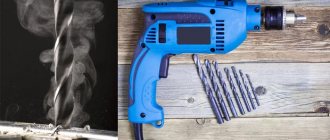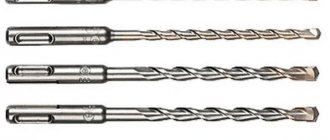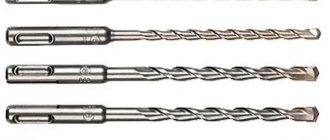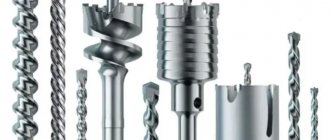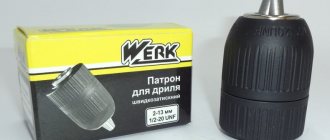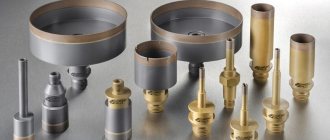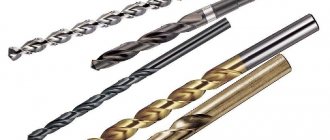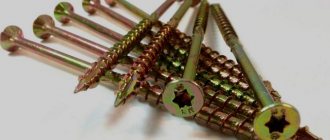Drill and drill: what's the difference?
There are two main types of equipment for a rotary hammer. Drills are used in hammer drills. They make a hole with sharply sharpened ribs arranged in a spiral.
Drills of various diameters are used to pierce more durable foundations. Unlike simple rotational movements of the drill, this equipment also performs shock and vibration movements.
Drills are not suitable for use in a drill socket, and have their own design features:
- there is a landing shank at the end of the equipment,
- mounting grooves that fit only into the hammer drill socket,
- screw rod.
The latter feature allows the nozzle not only to make holes, but at the same time to remove the resulting debris out. The strength characteristics of the drill are added by a pobedite or diamond tip.
How to remove a jammed drill bit from a hammer drill
There are several simple ways to remove a drill bit stuck in it from a hammer drill chuck.
- The free part of the drill, which is stuck in the hammer drill chuck, must be clamped in a vice, and then gently tapped on the cams of the clamping mechanism with a hammer, using a wooden spacer.
- If the method described above for removing a stuck drill does not help, then the cartridge can be placed in a container with gasoline, and then try to remove the drill in the usual way.
- If the drill is jammed in a key-type chuck, you should turn the key of such a mechanism counterclockwise, which will free the tool. If necessary, you can drop machine oil into the key type chuck in which the drill is stuck.
- — To remove a drill that is jammed in the keyless chuck, you can try to loosen the clamp of the fastening mechanism with gentle blows made counterclockwise.
- The last option for freeing a drill that is jammed in a hammer drill chuck is to completely disassemble the fastening mechanism.
Pobedite or diamond tip: which is better?
Which drills are best to choose are determined depending on what the surface being treated is made of. The rod of any equipment is crowned with a tip or solder. It has edges of various configurations and hard alloys are used for its manufacture.
The quality of drilling, wear resistance of the drill, and the speed at which it punches holes are determined by soldering. Therefore, it is better not to use a concrete drill bit for a hammer drill if you plan to work with marble tiles or masonry. But the diamond tip can handle both heavy and reinforced concrete.
Pobedit brazings are divided into three strength classes:
- soft ones are inexpensive, they can choose low-grade concrete and brickwork for the hole;
- medium-strength ones are most often used in everyday life for minor repairs and amateur construction. Tips of this hardness cope well with concrete floors;
- High-strength types of drills can compete with their diamond counterparts, but not on reinforced concrete bases.
All pobedit tips (if used as intended) are designed for repeated use without sharpening.
Types of drills for hammer drills
Tips come in the following types:
- chisel;
- drill;
- lance or chisel lance;
- channel drill;
- crown.
A drill, similar to an ordinary twist drill, is used to make round holes, usually for a dowel or dowel-nail. In construction stores it is often defined as a drill bit for a hammer drill.
The chisel is designed for removing plaster, tiles, tiles or any other worn-out coating. It is convenient for them to carry out dismantling by simply prying up the material to be removed.
The lance is convenient to use when scoring or punching holes in concrete or other hard surfaces. The tool has a noticeably larger diameter than a drill and is characterized by increased “bounceability”. This tip is used when it is necessary to make larger holes, which can be achieved using a drill.
A channel drill is indispensable when you need to make grooves for wiring or installing interior items: guides for plasterboard structures, fastening sliding or false walls.
The crown is used to make holes for placing switches and sockets. Modern drills for rotary hammers are available in any size, among other things, for installing these electrical devices.
- alloyed;
- high-speed;
- carbonaceous.
For processing hard materials, drills are equipped with heavy-duty soldering.
Based on the type of working tip, drills are classified into the following types:
- Screw type, designed for making deep holes. Thanks to the spiral design and significant torque, crumbs and dust are removed, the load on the hammer is reduced, and the work time is reduced.
- Drill with a slight slope of working chutes. Used for work that requires little force, for example for making many shallow holes in relatively soft materials.
- A drill with a significant inclination of grooves, characterized by high drilling speed. The load on the hammer drill from such drills is higher than when using auger drills. Designed for making deep holes.
- Drills with one or more spiral grooves or grooves of a special shape. This tip ensures high drill stability, balanced rotation, and reduced vibration load on the hammer drill.
No less important is the shape of the rear part of the drill, clamped in the chuck - the shank.
The most commonly used:
- SDSplus. Used for low and medium power hammer drills. The depth into the cartridge is 4 mm, the size of the “tail” is 10 mm.
- SDS is a special guide system. The drill is held in the chuck by clamps. The diameter of the tail part is 10 mm.
- SDSmax. Format used in a powerful professional tool. The diameter of the shank is not 10, but 18 mm, the recess into the chuck is 9 mm.
- SDStop. Used primarily in BOSH rotary hammers. The tail size is 14 mm.
- SDSquick. It is also a development and is used in instruments of this brand only.
What types of drills and drills are there?
If a home craftsman often needs to use a drilling tool, then it makes sense to look at sets of drills for a rotary hammer in the store. With such a purchase, the master will be ready to work with any surface.
The set contains nozzles with different types of shank and all shapes of the working part. Equipment can be divided into two broad categories: through and through.
The first ones choose the base material, gradually going deeper inside. The second type destroys (chips off, knocks off) an impressive part of the working surface. Within each group there is an additional breakdown into species.
How to choose?
Hammer drills are divided into models with different coatings.
- Oxide. The exterior of the drills is painted black - this is the cheapest coating. The film covering the drill protects the hammer drill chuck from overheating and rust, increasing its service life.
- Titanium-aluminum nitride coating. Allows you to increase the service life of drills by 5 times. Reliable and high quality drills.
- Ceramic coating. These drills are not made of pure ceramics, but of titanium nitrides. The disadvantage of this coating is the impossibility of sharpening the nozzle.
- Carbonitride titanium coating. It also increases the service life of nozzles and is highly durable.
- Diamond spraying is intended for working with stone and porcelain stoneware surfaces.
When purchasing, you should pay special attention to some characteristics
- Drill shank type. It is imperative to take into account the type of shank, otherwise the drill will not be securely fixed in the chuck, which will lead to equipment failure. To find out the type of cartridge, you can use the instructions included with the tool. The shanks of hammer drills are marked SDS-max and SDS-plus and are made in a more complex shape than drill bits for drills.
- Manufacturer. Many popular companies produce a whole range of tools with different pricing policies. Most often in stores you can find high-quality products for household needs at quite affordable prices, but professional tools are difficult to find.
- Drill length The length of the total or only the working surface can be indicated.
- Head diameter. To work with various materials, drills with the appropriate diameter are used. A hole smaller than the desired size will be quite difficult to enlarge using a narrow drill. In addition, this will lead to poor-quality work, which will affect the degree of fixation of the fasteners of the installed mechanism.
- Grooves. The grooves of drills are different: semicircular, with protrusions and beveled. The first are intended for household work that does not require high precision. The last two types are used in large enterprises due to their ability to quickly drain.
- Carbide groove. Smooth and smooth surfaces of drills are designed for working with soft materials or the external surfaces of bolts and screws. On drills, the geometric surface of the drill tip is sharper and comes in complex shapes - this is due to the impact mode of operation.
Screw attachments
The category of the most used attachments is represented by auger drills. Their cutting edge is twisted into a spiral, and the tip is additionally hardened.
If you need to make a deep hole in a matter of seconds, these are the nozzles you use. They are purchased to hang a shelf, sconce or TV bracket.
Kinds
What is a drill and why is it not a drill? To choose the right tool, it is worth considering what equipment will be used to perform the work. At their core, a drill and a drill are one and the same:
- drills are used in drills with various functions; they create recesses and holes in various surfaces;
- The drill works with a hammer drill; it is a long drill that is designed for working with hard and dense materials; it is capable of creating deep holes.
Working with wood
Twist drills are used to create holes in wood surfaces, which can also be used for working with metal. But to achieve a clean and neat recess, drills with a special attachment and recess are used. They are made from carbon or alloy steel and are designed for wood only.
Borers are divided into several types.
- Screw. It has only one spiral and has a particularly sharp edge. This shape allows you to minimize the scattering of chips during operation of the hammer drill, allowing you to clearly see the drilling site. The edges of the treated surface are smooth along the entire length.
- Spiral. Designed to work on medium-thick surfaces, for example, to create holes for cabinet handles.
- Feather. Designed for shallow recesses (about 2 cm).
- Fostner drill. Designed for fastening type holes (for example, for hinge holders of hinged doors). A distinctive feature is the presence of a point for centering and a trimmer with a sharpened edge.
- Annular. Outwardly it looks like a crown or a glass with corners around the edges. Used for recesses with a diameter of 10 cm or more.
For metal surfaces
These drills have the following characteristics:
- cobalt alloy hammer drill is designed to work with high-strength steel;
- soft metals (aluminum, non-ferrous materials) are processed with extra-long twist drills;
- drills with a cylindrical tip made of carbide are considered universal.
For concrete
When equipping a hammer drill with a drill, it is necessary to take into account the material from which the drill is made. Soft and low-quality drill bits can break when processing high-strength concrete.
There are several categories of drills.
- Auger drill. The tip of this drill is equipped with either a spade-like attachment or working teeth (most often there are four of them). The nozzle must be hardened, thus acquiring a golden hue. Such drills do not require constant sharpening and last an almost unlimited amount of time.
- Twist drill. Such drills are equipped with special recesses that ensure quick removal of residual materials and have a length of 8 cm or more. This design allows you to create holes at great depths.
- Core drill. Like all drills of this type, core drills have a large cutting surface diameter. The ends of the edges are treated with diamond sputtering or hard fused plates.
Step drills
This category of drills is distinguished by speed and quality of work. They are designed to work with various materials: wood, plastic, pipes, any soft and hard surfaces. The sharp tip allows you to accurately cut into the material being processed, and it also eliminates the need for a centering element, which greatly simplifies the work.
A step drill replaces the use of angle grinders and needle files and does not require manual processing of the ground surface. The conical shape is formed by progressive grooves of various diameters, the transition between each section is 30-45 degrees. This drill silhouette effectively copes with the processing of thin metal. Another feature of this attachment is that it is universal. Allows you to replace a set of drills from a diameter of 4 mm to 50 mm.
Spiral drills
This type of consumable is indispensable when you need to make a long passage of large diameter. If you need to stretch a cable through load-bearing partitions from one room to another, choose a spiral drill.
The use of concrete drills for other materials
There is an opinion among many ordinary people that drills, regardless of their purpose, are a universal tool that can cope with any material, it’s only a matter of time. This, of course, is a misconception: anyone who has tried to drill through a brick wall or metal with a wood drill will confirm this. A wood drill is designed for drilling wood by removing chips at an angle close to a straight line; for metal, the drill also removes chips, but at an angle of about 45 degrees, gradually penetrating into it, the Pobedit drill crumbles and pierces concrete.
If you apply a concrete drill to wood, it will simply crumble the wood and the hole will look disgusting, and if you try to drill into metal, the bit will not last long, its edges will simply wear off.
Crowns
When working with concrete foundations, it is often necessary to use crowns. Such equipment is needed when laying electrical wiring and engineering systems.
To select a round hole of large diameter (for example, for a socket), purchase a spiral-shaped rod with an attachment. The crown has incisors along the edges, making it easy to penetrate into concrete.
How to combine a hammer drill with a regular drill
Rotary hammers use a universal chuck, which is used both for drilling and when chiselling is necessary. In it, torque is transformed into reciprocating movements or rotation. For this reason, hammer drill chucks must be able to withstand both axle load and torque.
Under certain operating modes, these loads can act simultaneously, therefore the use of simple collet clamps, like a drill, is unacceptable.
The device of the adapter chuck for the drill
The drill shank, inserted into the clamp, has a cylindrical or conical shape. It has two pairs of grooves running along its entire length - two open and two closed.
- a splined bushing mounted on the motor shaft;
- sleeve ring;
- a cone-shaped spring supporting the ring;
- retaining balls placed between the sleeve and the ring;
- a casing that covers the entire assembly.
The drill is secured when the shank enters the sleeve. In this case, the open grooves coincide with the splines, and the balls supporting the ring fit into hidden holes. As a result, the drill is prevented from falling out of the clamp; torque is transmitted from the shaft through splines. The heel of the shank receives impulses from the hammer hammer.
How are drills marked and what sizes of nozzles are there?
Before inserting a drill into a hammer drill, you should make sure that you purchased a consumable with the type of shank recommended by the manufacturer (that is, all holes and shapes match the mount). Professionals advise choosing shanks with SDS fastening. It makes it possible to quickly change equipment and comes in 5 types:
- SDS plus is distinguished by the presence of 4 grooves with a diameter of 10 mm. The drills themselves can have a diameter of at least 0.4 cm and a maximum of 2.6 mm. They work great on concrete bases;
- SDS has 2 grooves, diameter 10mm;
- SDS max has five slots and is used for fastening powerful drills in rotary hammers for professional work. The diameter of the equipment increases from 2 to 8 cm;
- SDS top is distinguished by the presence of 4 grooves with a diameter of 1.4 cm. The size of the nozzles for this mount varies from 1.6 cm to 2.5 cm. This equipment is used in medium-weight hammer drills.
- The longitudinal projections in the SDS quick mount seem to have affected their popularity. They are rarely found on store shelves.
In addition to the type of fastening, the type of work to be done should influence the purchase of a particular consumable. Drill sizes for simple household work are limited to 6-10 mm.
Which polyurethane foam is better: tips on how to choose, review of characteristics, properties and features of modern foams- Choosing a blade for a hacksaw for metal: rating the best blades, choosing and using the best tool
Review of diamond bits for concrete: subtleties of choosing and using tools for high-quality drilling
If you need to screw an anchor bolt into the wall, you will need to take equipment of at least 2 and no more than 20 mm.
Another indicator of the drill size is the length of the working part and the main length. For private construction, where thick partitions are almost always erected, both a modest 10 cm nozzle and professional meter-long equipment may be required.
The walls in apartments are much thinner, and for standard repair work a 6 mm drill with a length of 110 mm will be sufficient.
To summarize, we can say that the choice of consumables for a hammer drill is made after assessing the scale and complexity of the upcoming work.
Possible problems
A common problem is the drill bit jamming in the equipment chuck. To extract it, you should choose one of several convenient methods:
- the free end of the drill is clamped in a vice and lightly tapped with a hammer with a rubber gasket on parts of the clamping mechanism;
- The hammer drill chuck is placed in a bowl of gasoline and the drill is subsequently removed;
- if a jam occurs in a key-type clamping mechanism, you need to turn the key counterclockwise or add a drop of machine oil;
- a stuck drill in a quick-release chuck is removed by tapping parts of the chuck counterclockwise;
- Complete disassembly of the equipment is possible if none of the methods help.
To learn how to clamp regular drills into a hammer drill, see the following video.
